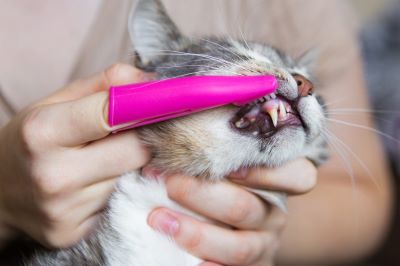Preventing gum disease in cats and dogs

When was the last time you took a good look inside your pet’s mouth? We're often conscious of the health considerations of our pets that are easy to spot - the condition of their coat, their weight, their movement and behaviour…It can be easy to forget that one of the most common health problems in cats and dogs is tucked away inside their mouths. Yes, it’s gum disease.
Gum disease occurs when food accumulates at the gum line, turning into plaque and then forming tartar. Bacteria starts to develop here, eroding the gums and compromising the bone and structures that support the teeth. This can lead to some tricky issues, like pain, tooth loss, and even infections that affect other parts of the body.
So, how can you prevent gum disease in your pets?
Brush your pet’s teeth regularly
Just like us humans, pets need to have their teeth brushed regularly to prevent gum disease. You can use a pet-specific toothbrush and toothpaste to brush their teeth. You should aim to brush their teeth at least twice or three times a week. Of course, if your pet hasn’t had their teeth brushed before and already appears to have swollen or tender gums, they’re not likely to take kindly to having a brush in their mouth, so take them to the vet for advice first.
Dental chews and toys
Dogs love to chew on things, so chew toys are a great way to keep their teeth clean while also keeping them amused. Dental chews are available for both cats and dogs, and they’re also ideal for preventing the build-up of plaque and tartar.
Visit your vet regularly
Regular check-ups with your vet can help catch any signs of gum disease early and prevent things from getting worse.
Ensure your pet has a healthy diet
A healthy diet can also help prevent gum disease in pets. Choose a high-quality pet food that’s low in sugar and high in nutrients. Feeding your pet dry food can help reduce the build-up of plaque and tartar due to the friction caused by chewing.
Do you know how to spot the signs of gum disease?
Like most health problems, the earlier you notice something is wrong, the easier it is to treat. Be on the lookout for common signs of gum disease in your pet, including bad breath, swollen or bleeding gums, and difficulty eating.
If you think your pet has gum disease, take them to your vet as soon as you can. Your vet can examine their teeth and gums, and if necessary, recommend a dental cleaning under anaesthesia. This is certainly a health condition that is much easier to avoid than it is to treat, so it’s worth taking the time to keep your pet’s teeth clean and healthy as part of their daily routine.
